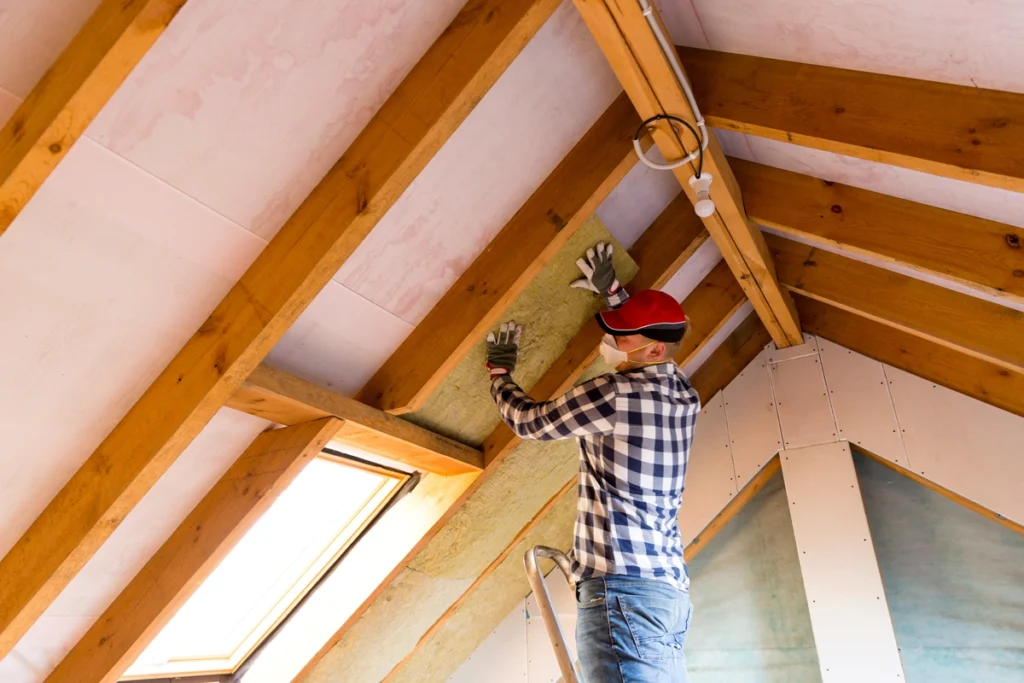How Does Insulation Work In A Roof? (Homeowner’s Guide)
Posted: May 21, 2024
When it comes to maintaining a comfortable and energy-efficient home, proper roof insulation plays a crucial role. Understanding how insulation works, the different types available, and their benefits can help homeowners make informed decisions. This comprehensive guide will help answer the question “how does insulation work?“, and explore the mechanics of roof insulation and its benefits, including:
- Understanding roof insulation
- 5 benefits of roof insulation
- 4 types of roof insulation
- Choosing the right insulation
- Installation process
- Maintenance and upkeep
🤔 Understanding Roof Insulation

Roof insulation refers to materials installed within the roof structure to reduce the transfer of heat between the interior and exterior of a home. It acts as a barrier that helps maintain a consistent indoor temperature, regardless of the weather outside.
How Does Heat Transfer Work?
To understand how insulation works, it’s essential to grasp the concept of heat transfer, which occurs in three ways:
Conduction
- This is the transfer of heat through a solid material. When one side of a material is heated, the heat flows through the material to the cooler side. For example, heat from the sun can transfer through your roof materials into your attic.
Convection
- This involves the movement of heat through fluids (liquids and gases). In a home, warm air rises and can escape through the roof, while cooler air can infiltrate the lower levels.
Radiation
- Heat transfer through electromagnetic waves, such as the sun’s rays heating your roof.
How Insulation Works
Insulation works primarily by reducing conductive and convective heat transfer. The materials used in insulation have properties that trap air or reflect heat, thus impeding the movement of heat through the roof.
Reducing Conduction
- Insulating materials, such as fiberglass, foam, or cellulose, contain air pockets that slow down the conduction of heat through the roof.
Reducing Convection
- Properly installed insulation prevents the movement of air within the roof space, reducing heat loss in the winter and heat gain in the summer.
Reflecting Radiation
- Some insulation materials, like radiant barriers, reflect radiant heat away from the home, further enhancing the insulating effect.
✅ 5 Benefits of Roof Insulation
Roof insulation plays a vital role in enhancing the overall energy efficiency and comfort of your home. Properly installed insulation can lead to significant savings on energy bills, contribute to a more consistent indoor temperature, and improve your property’s overall value. Let’s explore five key benefits of investing in quality roof insulation.
1. Energy Efficiency
One of the primary benefits of roof insulation is improved energy efficiency. By reducing the amount of heat entering or escaping your home, insulation helps maintain a stable indoor temperature, reducing the need for heating and cooling systems. This leads to lower energy consumption and, consequently, lower utility bills.
2. Comfort
Insulation enhances the overall comfort of your home. It keeps the indoor temperature more consistent, reducing cold drafts in the winter and excessive heat in the summer. This makes living spaces more enjoyable year-round.
3. Environmental Impact
Reducing energy consumption not only saves money but also has a positive impact on the environment. Lower energy use means fewer fossil fuels are burned to generate electricity, leading to reduced greenhouse gas emissions and a smaller carbon footprint.
4. Noise Reduction
Insulation also acts as a sound barrier, reducing the amount of external noise that enters your home. This is particularly beneficial if you live in a noisy neighborhood or near busy streets.
5. Increased Home Value
A well-insulated home is often more attractive to potential buyers. It signifies that the home is energy-efficient and likely to have lower utility costs, making it a valuable investment.
🏠 4 Types of Roof Insulation
Choosing the right roof insulation is crucial for maximizing energy efficiency and maintaining a comfortable indoor environment. In this section, we will explore four popular types of roof insulation materials, discussing their benefits and ideal applications.
1. Blanket Insulation
Fiberglass Batts:
- Fiberglass batts are one of the most common types of insulation. They are made from fine glass fibers and come in pre-cut panels. They are easy to install and offer good thermal performance.
Mineral Wool:
- Mineral wool insulation, made from rock or slag, is similar to fiberglass but offers better fire resistance and soundproofing qualities. It is also available in batts and rolls.
2. Loose-Fill Insulation
Cellulose:
- Cellulose insulation is made from recycled paper products and treated with fire retardants. It is blown into the roof space using specialized equipment, making it ideal for irregularly shaped areas.
Fiberglass:
- Loose-fill fiberglass insulation is similar to its batt counterpart but is applied by blowing the fibers into the roof space. This allows for better coverage in hard-to-reach areas.
3. Spray Foam Insulation
Open-Cell Foam:
- Open-cell spray foam is less dense and has a lower R-value (a measure of thermal resistance) compared to closed-cell foam. It expands upon application, filling gaps and creating an air-tight seal.
Closed-Cell Foam:
- Closed-cell spray foam is denser and has a higher R-value. It provides excellent thermal resistance and adds structural strength to the roof. It is also highly resistant to moisture.
Reflective or Radiant Barrier Insulation:
- Radiant barriers are installed in the attic to reflect radiant heat away from the home. They are typically made from aluminum foil and are most effective in hot climates.
4. Structural Insulated Panels (SIPs)
SIPs are pre-fabricated panels consisting of an insulating foam core sandwiched between two structural facings. They offer high thermal resistance and are used in new construction for efficient building envelopes.
🧐 Choosing the Right Insulation

Selecting the appropriate insulation for your home is a critical decision that impacts both energy efficiency and comfort. With various types of insulation available, each with unique benefits and applications, understanding your specific needs is essential for making an informed choice. In this section, we will guide you through the factors to consider when choosing the right insulation for your home.
- Climate Considerations: The climate in your area plays a significant role in determining the best type of insulation for your roof. For instance, homes in colder climates may benefit from thicker insulation with a higher R-value, while those in warmer climates might prioritize radiant barriers.
- Roof Structure: The type of roof you have (flat, pitched, or vaulted) will also influence your insulation choices. Some materials are better suited for certain roof structures, and the installation process may vary.
- Budget: Cost is always a factor when it comes to home improvement projects. While some insulation types may have a higher upfront cost, they can offer better energy savings over time. It’s important to balance initial costs with long-term benefits.
- Installation Complexity: Some insulation materials are easier to install than others. DIY-friendly options like fiberglass batts might be appealing to homeowners looking to save on installation costs, while spray foam typically requires professional installation.
🔨 Installation Process
Installing insulation is a critical step in enhancing the energy efficiency and comfort of your home. In this section, we will walk you through the key stages of the insulation installation process, ensuring you understand the best practices and materials needed for optimal results.
1. Preparation
- Assessment: Evaluate the current state of your roof and attic space. Identify any existing insulation, potential air leaks, and areas that need additional coverage.
- Sealing Air Leaks: Before installing insulation, seal any air leaks in the roof and attic. This includes gaps around vents, chimneys, and electrical penetrations.
- Safety Measures: Ensure you have the necessary safety equipment, such as gloves, masks, and goggles, especially when handling materials like fiberglass.
2. Insulation Options
Blanket Insulation
- Measure and Cut: Measure the spaces between roof rafters and cut the batts or rolls to fit.
- Fit and Secure: Place the insulation between the rafters, ensuring it fits snugly without compressing. Use staples or wire to secure the insulation in place.
Loose-Fill Insulation
- Set Up Blower: Rent or purchase a blower machine for installation.
- Distribute Evenly: Use the blower to distribute the insulation evenly across the attic floor, filling all gaps and corners.
Spray Foam Insulation
- Professional Application: Hire a professional for spray foam installation, as it requires specialized equipment and expertise.
- Apply Foam: The professional will spray the foam onto the roof underside, where it expands and hardens, creating an air-tight seal.
Radiant Barriers
- Attach to Rafters: Staple the radiant barrier to the roof rafters, leaving a gap between the barrier and the roof deck to allow for air circulation.
- Cover Entire Area: Ensure the entire roof area is covered for maximum effectiveness.
3. Post-Installation Checks
- Inspect Coverage: Check that all areas are properly covered and that there are no gaps or compressed spots in the insulation.
- Check Ventilation: Ensure that attic ventilation is not obstructed by the insulation. Proper ventilation is crucial to prevent moisture buildup and roof damage.
💡 Maintenance and Upkeep
Regular maintenance and upkeep are crucial to ensuring the longevity and functionality of your roofing system. At SMR Homes, we provide comprehensive maintenance services designed to address common issues and prevent potential damage. Let’s explore the essential steps and best practices to keep your roof in top condition.
- Regular Inspections: Inspect your roof insulation regularly for signs of damage, moisture, or pest infestations. Address any issues promptly to maintain the effectiveness of your insulation.
- Addressing Moisture Issues: Moisture is a significant threat to insulation effectiveness. Ensure your roof is in good condition and that there are no leaks. If you notice any dampness in your insulation, find and fix the source of the moisture immediately.
- Replenishing Insulation: Over time, insulation can settle or degrade. Replenish or replace insulation as needed to maintain optimal thermal performance. This is particularly important for loose-fill insulation, which may settle more than other types.
- Upgrading Insulation: As building standards and insulation technologies improve, consider upgrading your insulation to more energy-efficient materials. This can provide better thermal resistance and further reduce your energy costs.
🙌 The Importance of Roof Insulation: Expertise and Benefits from SMR Homes
Proper roof insulation is essential for creating a comfortable, energy-efficient home. At SMR Homes, we understand the different types of insulation available, their benefits, and the installation process. Our expertise ensures homeowners can make informed decisions that enhance their living environment and save money in the long run. With regular maintenance and upgrades, our team guarantees that your insulation continues to perform effectively, providing long-term benefits for both your home and the environment.
Investing in quality roof insulation with SMR Homes is a smart choice that pays off in improved comfort, reduced energy bills, and increased home value. Whether you’re planning a project or need professional assistance, trust our team to deliver exceptional results. Contact SMR Homes today to get started and experience the difference!
